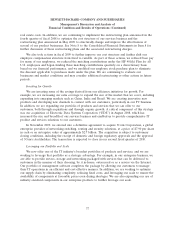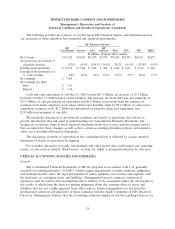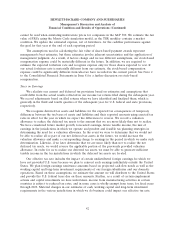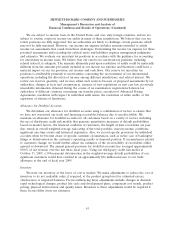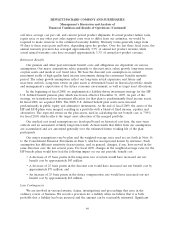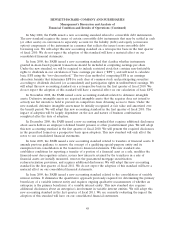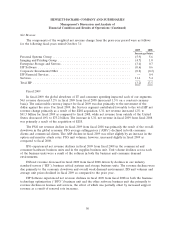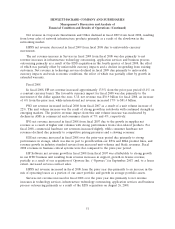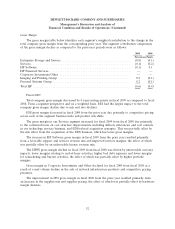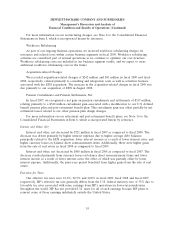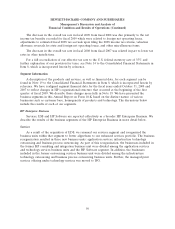HP 2009 Annual Report Download - page 54
Download and view the complete annual report
Please find page 54 of the 2009 HP annual report below. You can navigate through the pages in the report by either clicking on the pages listed below, or by using the keyword search tool below to find specific information within the annual report.HEWLETT-PACKARD COMPANY AND SUBSIDIARIES
Management’s Discussion and Analysis of
Financial Condition and Results of Operations (Continued)
judgment is required to determine both probability and the estimated amount. We review these
provisions at least quarterly and adjust these provisions to reflect the impact of negotiations,
settlements, rulings, advice of legal counsel, and updated information. Litigation is inherently
unpredictable and is subject to significant uncertainties, some of which are beyond our control. Should
any of these estimates and assumptions change or prove to have been incorrect, it could have a
material impact on our results of operations, financial position and cash flows.
ACCOUNTING PRONOUNCEMENTS
In September 2006, the FASB issued a new accounting standard related to fair value
measurements. The new standard defines fair value, establishes a framework for measuring fair value,
and expands disclosures about fair value measurements. In February 2008, the FASB issued a new
provision which delayed the effective date of the fair value measurements and disclosures for all
nonfinancial assets and nonfinancial liabilities, except those that are recognized or disclosed at fair
value in the financial statements on a recurring basis (at least annually). In August 2009, the FASB
issued ASU No. 2009-05, ‘‘Measuring Liabilities at Fair Value’’ in relation to the fair value
measurement of liabilities. We adopted the applicable portions of the provisions of the new standards
in the first and fourth quarters of fiscal 2009, and will adopt the provision related to the nonfinancial
assets and nonfinancial liabilities in the first quarter of fiscal 2010. Although we will continue to
evaluate the application of the provision for the nonfinancial assets and nonfinancial liabilities, we do
not expect the adoption to have a material impact on our consolidated financial statements. See Note 9
to the Consolidated Financial Statements in Item 8 for additional information pertaining to fair value
measurements.
In December 2007, the FASB issued a new accounting standard related to business combinations.
The new standard expands the definition of a business and a business combination; requires recognition
of assets acquired, liabilities assumed, and contingent consideration at their fair value on the acquisition
date with subsequent changes recognized in earnings; requires acquisition-related expenses and
restructuring costs to be recognized separately from the business combination and expensed as
incurred; requires in-process research and development to be capitalized at fair value as an indefinite-
lived intangible asset; and requires that changes in accounting for deferred tax asset valuation
allowances and acquired income tax uncertainties after the measurement period be recognized as a
component of provision for taxes. The new standard also establishes disclosure requirements to enable
the evaluation of the nature and financial effects of the business combination. In April 2009, the FASB
issued a new standard which clarified the accounting for pre-acquisition contingencies. We will adopt
these new business combination standards in the first quarter of fiscal 2010. The impact of adoption
will be largely dependent on the size and nature of the business combinations completed after the
adoption of this statement.
In December 2007, the FASB issued a new accounting standard related to noncontrolling interests.
The new standard establishes accounting and reporting standards for ownership interests in subsidiaries
held by parties other than the parent, the amount of consolidated net income attributable to the parent
and to the noncontrolling interest, changes in a parent’s ownership interest, and the valuation of
retained noncontrolling equity investments when a subsidiary is deconsolidated. The new standard also
establishes disclosure requirements that clearly identify and distinguish between the interests of the
parent and the interests of the noncontrolling owners. We will adopt this new accounting standard in
the first quarter of fiscal 2010. We do not expect the adoption of this standard will have a material
effect on our consolidated financial statements.
47


